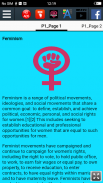








History of feminism

توضیحات History of feminism
The history of feminism is the chronological narrative of the movements and ideologies aimed at equal rights for women. While feminists around the world have differed in causes, goals, and intentions depending on time, culture, and country, most Western feminist historians assert that all movements that work to obtain women's rights should be considered feminist movements, even when they did not (or do not) apply the term to themselves.[1][2][3][4][5] Other historians limit the term to the modern feminist movement and its progeny, and instead use the label "protofeminist" to describe earlier movements.[6]
Modern Western feminist history is split into three time periods, or "waves", each with slightly different aims based on prior progress.[7][8] First-wave feminism of the 19th and early 20th centuries focuses on overturning legal inequalities, particularly women's suffrage. Second-wave feminism (1960s–1980s) broadened debate to include cultural inequalities, gender norms, and the role of women in society. Third-wave feminism (1990s–2000s) refers to diverse strains of feminist activity, seen as both a continuation of the second wave and a response to its perceived failures.[9] Although the waves construct has been commonly used to describe the history of feminism, the concept has also been criticized for ignoring and erasing the history between the "waves", by choosing to focus solely on a few famous figures, and popular events.[10]
تاریخ فمینیسم روایت زمانی از جنبش و ایدئولوژی با هدف حقوق برابر برای زنان است. در حالی که فمینیست در سراسر جهان در علل، اهداف و مقاصد بسته به زمان، فرهنگ، و کشور متفاوت است، بسیاری از مورخان فمینیست غربی ادعا می کنند که تمام حرکات است که کار برای به دست آوردن حقوق زنان باید در نظر گرفته شود جنبش های فمینیستی، حتی زمانی که آنها را نداشتند (و یا انجام نمی شود) اعمال مدت به خود است. [1] [2] [3] [4] [5] مورخان دیگر محدود کردن مدت به جنبش فمینیستی مدرن و فرزندان خود را، و به جای استفاده از برچسب "protofeminist" برای توصیف جنبش های پیش از آن. [6]
مدرن تاریخ فمینیسم غربی، به سه دوره زمانی، و یا "امواج"، هر کدام با اهداف کمی متفاوت بر اساس پیشرفت قبل تقسیم می شود. [7] [8] موج اول فمنیسم در قرن 20 و اوایل 19 در واژگونی نابرابری حقوقی، به ویژه حق رای زنان متمرکز است. موج دوم فمینیسم (1960s به-1980s) گسترش بحث به شامل نابرابری های فرهنگی، هنجارهای جنسیتی و نقش زنان در جامعه است. موج سوم فمینیسم (1990s به-2000S) به گونه ای متنوع از فعالیت های فمینیستی، به عنوان یک ادامه از موج دوم و در پاسخ به شکست درک آن دیده می شود، اشاره دارد. [9] اگر چه ساختار امواج شده است معمولا برای توصیف تاریخ فمینیسم استفاده می شود، مفهوم نیز برای نادیده گرفتن و پاک کردن تاریخچه روابط بین "امواج" انتقاد قرار گرفته است، با انتخاب به تمرکز صرفا بر روی چند چهره معروف، و حوادث محبوب. [10 ]
























